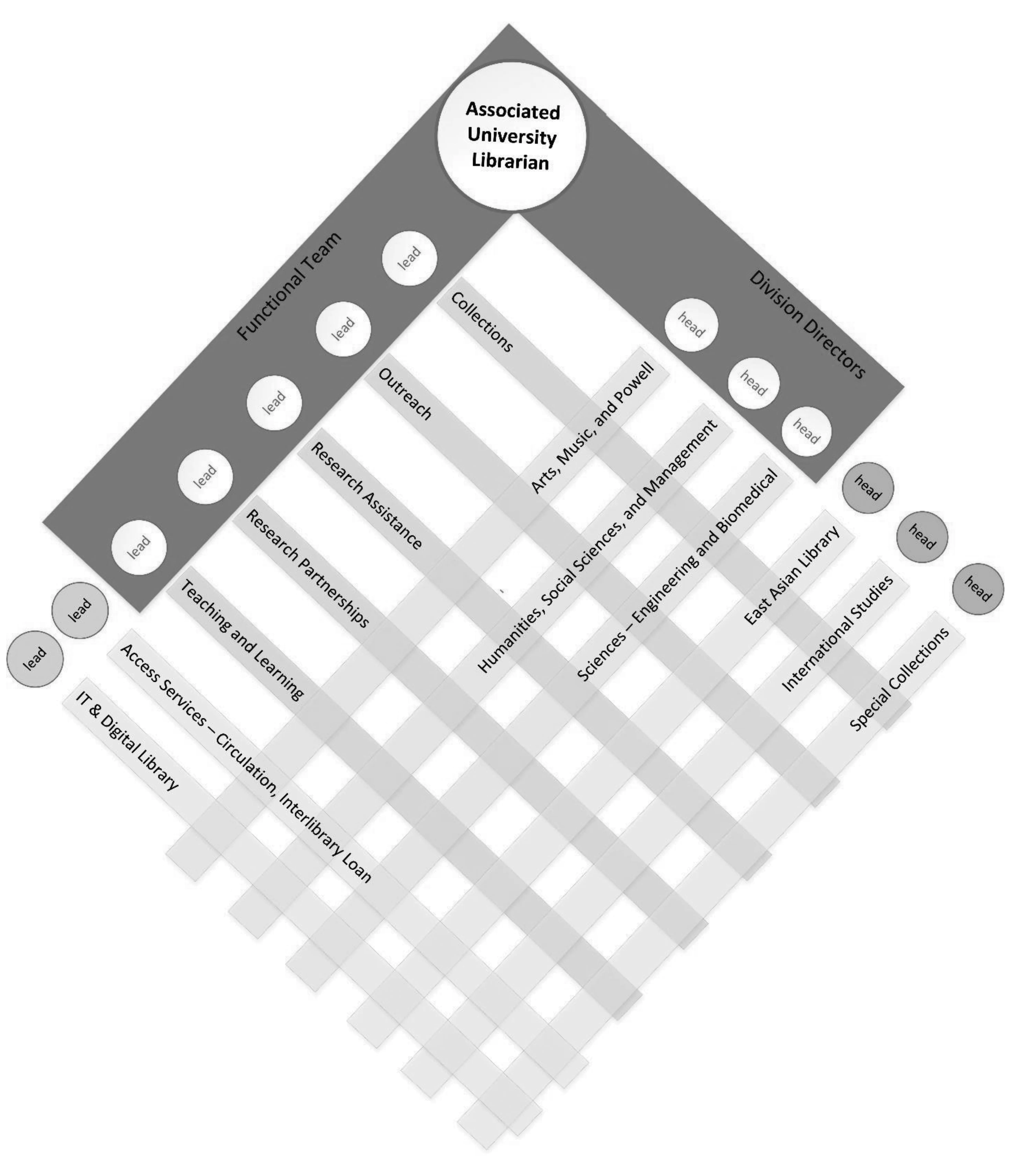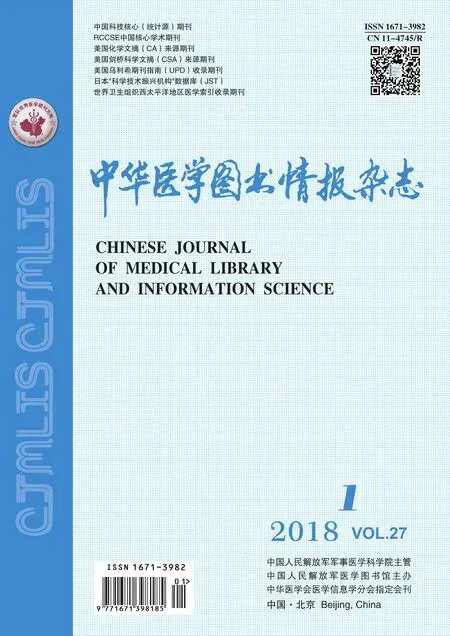Building teams: reaching beyond medical libraries for inspiration
,, ()
Director,Louise M.Darling Biomedical Library and Science and Engineering Library,Sciences User Engagement,UCLA Library
[Abstract]Research model in our UCLA Library has also transformed into collaborative and interdisciplinary as a research community. The most successful units within the library work in this cooperative way. However, most of the public service units still work in their own silo. Building research and service teams to achieve the library's development strategic plan that paves the way for a reorganization of the public service units in the library is the most effective and proper way. In order to address this accomplishment, the User Engagement division of UCLA Library has launched. This article demonstrates the reason why UCLA Library need to build the team and the way in which UCLA Library use to build the team in order to bring about the goal of reaching beyond medical libraries for inspiration.
[Key words]Research model; Collaborative; Interdisciplinary; UCLA Library; Building teams; Beyond
Research in the scientific community is often collaborative and interdisciplinary. This model has recently been extending into the social sciences and humanities communities. The most successful units within the UCLA Library have been ones that have been able to work cross-departmentally to accomplish goals and further the library′s mission.However,until recently,most public service units in the UCLA Library reported up to the University Librarian through different Associate University Librarians.Each subject library did research assistance (reference),outreach to faculty,collection development,and teaching services in their own way.Each subject library worked in their own silo.Since the most successful libraries mirrored the collaborative and interdisciplinary work seen in our larger academic community,it was time for a change-a reorganization of public service units in the UCLA Library.Out of this recognized need,the User Engagement division of UCLA Library was formed.
Building the Team: Why
Reviewing our library structure,senior leadership in the library acknowledged a change was needed. The way individual libraries worked,activities were being duplicate and staff energy was being expended creating parallel systems. Multiple librarians were trying to set up new services to partner with our faculty throughout their research life cycle. Several librarians in various libraries were struggling with similar collection development challenges related to training new librarians or negotiating for new resources. Every library had a service point for reference related questions,but each library had their own policies and procedures for staffing those services points.It was in this environment that UCLA Library began developing a new strategic plan in 2015.
The strategic plan has six of elements.The library will: 1) "play a visible,vital,and valued role in UCLA′s Life," 2) "ensure effective access to information and resources," 3) "function as the heart that enables research to thrive," 4) "become a platform and catalyst for innovation in teaching and learning," 5) "develop a strong culture of engagement and leadership," and 6) "provide excellent spaces for people to be productive."[1]With a commonality of mission and an emphasis on leadership at all levels,the strategic plan paved the way for a reorganization of the public service units in UCLA Library. The division of User Engagement was formed to align eight libraries′ public service units under a single Associate University Librarian. The new division′s first task was to design a structure that would enable the success of the strategic plan,address the challenges of work happening in parallel/duplication in various library units,and facilitate the future growth of the library and its staff.
Building the Team: How
A redesign team of 13 individuals was led by the Associate University Librarian (AUL) for User Engagement.The individuals asked to join the team represented one of three aspects of our organization: 1) library units in the newly formed division,2) library stakeholders who had service relationships with the new division (circulation/interlibrary loan,special collections,international studies),or 3) evolving service initiatives (data management,teaching and learning services,outreach) outlined in the strategic plan.After discussion and brainstorming,three leading ideas were proposed by the group.First,User Engagement could become a new division and keep the eight individual library units as they were previously functioning (As-Is Structure). Second,User Engagement could organize by services across units,with librarians and staff reporting to the head of the service regardless of which library unit they worked in (Functional Structure). Third,User Engagement could organize by broad subject division,grouping the eight libraries into three subject divisions each led by a director reporting to the AUL (Subject Structure).
To evaluate the proposed plans the redesign team identified two challenge scenarios.Each scenario was based on a common problem faced in the existing structure. The redesign team was asked to split into three groups representing one of the proposed structures. Each team reflected on both scenarios,considering how the proposed structure they represented would improve on challenges related to decision making,budgeting,communication,and scoping of services.The resulting evaluation showed problems with each proposed structure separately to resolve the scenario challenges.However,combining the subject and functional models into a matrix reporting structure led to a unique opportunity to work through those challenges.
Building the Team: What
Matrix organizational structures have roots in the discipline of project management and have been used in larger organizational structures to leverage project leadership activities while centralizing administration leadership responsibilities external to the project team[2]. The team planning the new User Engagement structure acknowledged that oversight of personnel,budget,facilities,and the representation of unique subject discipline services were still necessary responsibilities. The team also acknowledged colleagues who were most successful in previous organizational structures had been able to work on functional projects across divisions and then leverage the project experience to move the organization in a new direction or to move themselves into management careers. A matrix structure (Figure 1) would give the opportunity for people to develop functional leadership skills through mentorship of division directors and the AUL. In this new structure there would be seven elements reporting directly or indirectly (consulting members) to the AUL.
1)Division directors (Figure 1,circles on left) are the heads of specific subject libraries. Directors supervise librarians and staff of the unit,conduct performance review,manage budget responsibilities,and provide long term vision for subject areas & divisions.Division Directors report 100% to the AUL and serve as members of the User Engagement Leadership Council.
2)Functional team lead (Figure 1,circles on right) is a librarian from a subject division who is assigned 50% of their time to leading in one of five functional areas (Collections,Outreach,Research Assistance,Research Partnerships,or Teaching and Learning). A team lead reports both to the AUL,for the 50% of their job allotted to functional leadership,and their division director,for the 50% of their job related to division responsibilities. They will implement their shorter term vision for the functional areas. The lead position is a two year term,with an application and interview process before selection. Team Leads serve as members of the User Engagement Leadership Council.
3)Functional team members are librarians and library staff in subject divisions (Figure 1,yellow bars) who work across all functional areas as part of their daily responsibilities. Team members were asked to self-identify in which one of the five functional areas they will spend 20% of their time leading cross departmental projects.The other 80% is dedicated to subject division responsibilities. A team member plays a bidirectional communication role by representing their subject division on the functional team and representing their functional team to their division.Because of the bidirectional role and 20% time commitment,functional team leads will contribute letters evaluating team members′ contributions in the performance review of each team member.
4)Consulting members are librarians and library staff from related units (Figure 1,gray bars on either side of the matrix) who can be called upon for consultative or membership roles in functional teams. With some library units reporting to another AUL,it is important to seek input and broad alignment for public service and functional areas. Consulting members join functional teams based on goals and discussion topics relevant to their group,but do not have the same time requirement of functional team members.
5)User Engagement Leadership Council (Figure 1,large blue bars) is the group of functional team leads and division directors reporting directly to the AUL. All members of the council have equally weighted voices during discussions of services and policies regarding the new division. The purpose of the group is to set service priorities and direction for the division in consultation with stakeholders,aligning functional and divisional needs.The group is also charged with developing a culture of leadership and engagement across the library.
6)Functional teams (Figure 1,light blue bands on left side) are constructed of team members from the subject division and a functional team lead. The teams lead the library′s approach to one of five functional areas-collections,outreach,research assistance (formerly called reference),research partnerships (library services in the research life cycle),and teaching and learning.The teams set priorities for services and guide policy setting in their functional area.
7)Subject Divisions (Figure 1,light yellow bands on right side) are groups of library units,loosely organized by subject.Divisions are led by the directors.Divisions contribute members to the functional teams,advocate for the unique research and educational approaches of their disciplines,and implements services for to support their disciplines′ needs.

Figure 1
Challenges and Opportunities in Creating a Matrix
Once roles were defined,the planning team reviewed the original call for change in the strategic plan and the challenge scenarios. The planning team wanted to generate a structure that would be effective at solving problems and increasing leadership opportunities. In order for this structure to be fully functional,leadership would need to be equally shared among those who had fiscal and supervisorial responsibilities and those who were leading functional service areas. Cultural change related to decision making and communication would be the key.During interviews for divisional directors and functional team leads,all candidates were asked questions about team oriented leadership and how they would enable this new shared leadership model.In addition,to create a solid culture of collaboration,one activity of the newly formed User Engagement Leadership Council (division directors,functional team leads,and AUL) was to establish explicit working norms-expectations of how the team functions together to accomplish their work[3].
Another challenge was developing an organizational culture that expected leadership from all members of the organization.Division directors and the AUL promoted the principles of cultural change within unit,dedicating time at regular meetings to discuss the different structure,the desired culture,and expectation of leadership from all team members to help move the library in this new direction.As part of a functional team,there would be opportunities to develop leadership and project management skills within a large academic library structure.Functional team lead positions were made to be a two year term to allow members to try out formal leadership positions for a limited time.At the end of the two years,a new call for team leaders will be announced giving other team members the opportunity to apply.It would also be possible for a team lead to finish a term leading in one functional area and then seek leadership in a different functional area,thus gaining the breadth of experience needed for senior level management positions.
The matrix structural shift has also presented new opportunities and a renewed vigor for the library.There is an overall sense among User Engagement leadership that work satisfaction has improved in the first quarter after implementation.Librarians and library staff have expressed increased engagement with work,excitement about daily activities,and desire to explore new commitments. Also,functional team leads and divisional directors have notice increased agency (the emotional and physical ability to affect change in an organization) in librarians and library staff as they suggest new activities made possible through the functional-divisional matrix shift and shared leadership model.
Results of the organizational redesign cannot be fully evaluated at such an early date.However,early experiences indicate success in accomplishing some goals related to cultural change. Ongoing evaluation of the reorganized matrix structure and alignment with the library′s strategic plan will continue.The keys to our organizational future lie in mirroring our academic community′s work style,interdisciplinary collaboration and engaged leadership.
 中華醫(yī)學(xué)圖書情報(bào)雜志2018年1期
中華醫(yī)學(xué)圖書情報(bào)雜志2018年1期
- 中華醫(yī)學(xué)圖書情報(bào)雜志的其它文章
- 文獻(xiàn)管理軟件功能向開放型科研社交網(wǎng)絡(luò)拓展的趨勢(shì)
- 信息學(xué)工作者在密歇根大學(xué)課程革新中的作用與合作
- Informationist roles and collaborations in curriculum innovation at the University of Michigan′s A.Alfred Taubman Health Sciences Library
- 醫(yī)學(xué)圖書館的研究整合
- “互聯(lián)網(wǎng)+”分級(jí)診療信息化體系構(gòu)建
- 中醫(yī)藥論文影響力評(píng)價(jià)系統(tǒng)(TCM-PIES)的設(shè)計(jì)與實(shí)現(xiàn)
